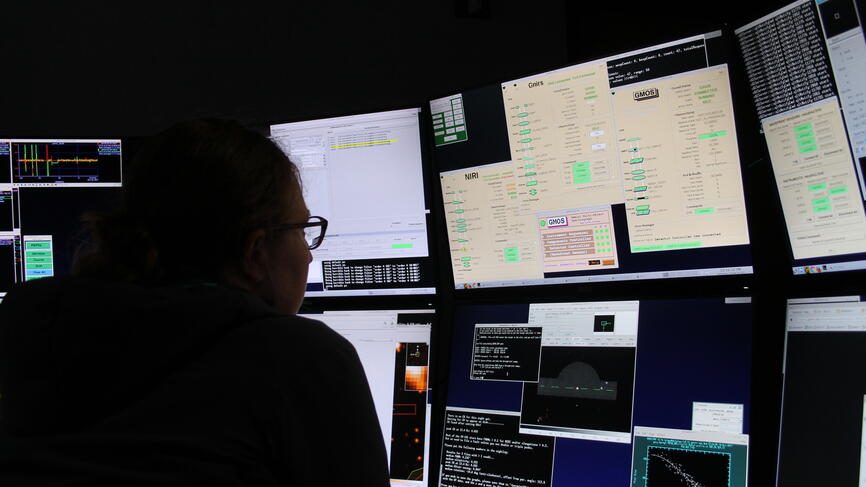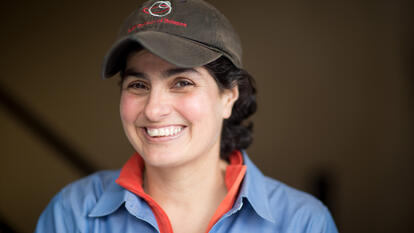
NASA Hubble Fellow Kathryn Neugent ’10 Is At Home Among the Stars
The first time Kathryn Neugent ’10 really saw the night sky was in sixth grade, on a weeklong camping trip to Yosemite National Park. On a group hike, she looked up at the stars and had a revelation. “That was kind of the moment that I was like, this is really cool, and I want to do this somehow,” she said. “That started the ball rolling for wanting to be an astronomer when I grew up.” When Neugent returned to her home in San Luis Obispo, Calif., she started saving for her first telescope. She still has it today.
In March, Neugent received a NASA Hubble Fellowship, which each year is awarded to some of the world’s most promising and innovative young astrophysicists. Fellows pursue independent research in any area of NASA astrophysics and receive up to three years of support at a university or research center of their choosing in the United States. Neugent, who holds an M.S. in applied physics from Northern Arizona University and a Ph.D. in astronomy from the University of Washington, will be continuing her research at Harvard on massive stars in binary systems. She will be focusing on the gravitational wave events such stars create when they merge after exploding, which ripple across space, and can be detected by the Laser Interferometer Gravitational-wave Observatory (LIGO), the same instrument Nergis Mavalvala ’90 used as part of the team that first directly detected gravitational waves from colliding black holes, groundbreaking work that fulfilled the last prediction of Einstein’s Theory of Relativity.
“By the time I left Wellesley, I had observed on the telescope a couple hundred nights, which is crazy—usually you go to grad school, and it’s there that you take your first observations.”
Kathryn Neugent ’10, NASA Hubble Fellow
Though Neugent is now among the country’s top young scientists, she had challenging experiences in some of her early science courses at Wellesley. In her first physics class, she said, she didn’t have as strong a background as her classmates who had taken AP physics in high school; the semester was difficult and led her to question her future goals. “That was the first big hurdle I had encountered,” Neugent said. “It was weird for me, because I had spent all this time wanting to be an astronomer.”
Meanwhile, her roommate was thriving in computer science. Neugent enrolled in a computer science course at her roommate’s suggestion, despite having had no previous experience with programming, and loved the small class sizes and the frequent student-faculty dinners. “It just felt like a very welcoming place,” Neugent said. “There was no expectation that you would come in knowing how to program. I really felt like I could start at the very beginning and build up.”
Ultimately, Neugent double majored in astronomy and computer science. “The rest of Wellesley, for me, was kind of a back and forth between computer science and astronomy,” Neugent said.
In her sophomore year, she joined a field camp program run by MIT over Wellesley’s Wintersession. She and a handful of MIT students traveled to Lowell Observatory, in Flagstaff, Ariz., to do astronomy research. At the end, she presented her research, and Phil Massey, an astronomer in the audience, was intrigued by her findings. He encouraged her to apply to Lowell’s summer research program. Neugent has been working with him ever since.
Over the next several years, in collaboration with Massey, Neugent published her research in astronomy, attended conferences, and went on observing runs around the world. Her work brought her to remote mountaintops in Chile, Hawai’i, and Arizona, where she used some of the world’s most powerful telescopes. “I was doing all of this amazing astronomy research, and getting paid for it,” Neugent said. “It would have been difficult to get a job like that if I hadn’t had that kind of summer experience when I was a Wellesley student. A lot of it was self-directed, but a lot of it was really made possible by this kind of research experience I had throughout all these years. And so I was able to publish and become a name in the field before I went to grad school, which is not the normal experience.”
Neugent also published some of her undergraduate research. “My first published paper was about asteroids, and based on all the observations I took using the Sawyer 24-inch reflector telescope up at the Whitin Observatory,” Neugent said. Having that kind of observing opportunity in college is rare: “By the time I left Wellesley, I had observed on the telescope a couple hundred nights, which is crazy—usually you go to grad school, and it’s there that you take your first observations.”

Neugent balanced her astronomy research with a burgeoning career as a cybersecurity expert. While working with Massey after graduating from Wellesley, she was also working as a web application penetration leader at both MITRE Labs and later the National Renewable Energy Laboratory. “My role was basically to try to hack web applications, and to help with developing security best practices,” Neugent said.
Eventually, Neugent decided to devote herself fully to astronomy, researching certain types of massive stars as a graduate student. “Massive stars are greater than eight times the mass of our sun, and can be up to hundreds of times the sun’s mass,” Neugent explained. “They are incredibly rare, and very important. They produce most of the heavy elements, including the oxygen that we breathe, and gold, and nitrogen. These important elements that lead to life were produced while a massive star was burning through its fuel or when one exploded as a supernova. Without massive stars, we would not have life. So they are fun to study, for so many reasons.”
As a Hubble fellow, Neugent will study the gravitational waves such stars produce when they explode and spiral in on one another. “This is one of these things that Einstein predicted, which we can now actually detect with LIGO,” Neugent said. “I think this will help us learn more about how matter interacts with each other, as well as give us new insight into how the universe was created, how galaxies evolve, and how everything else builds upon this knowledge.”
Neugent will observe massive stars, organize data, and write code to help with her simulations. “I’m just kind of looking at all these different binary star systems in different ways, to try and put together a bigger picture of how these massive star binaries work,” Neugent said.
In her own bigger picture, she sees teaching on the horizon. “I think I’ve always wanted to be a professor,” Neugent said. “I love advising students, and working with them. Good advising was such an important part of my undergraduate experience, alongside those research opportunities, so I’d love to be able to give that back. But for now, I’m going to enjoy these years of funding, and the research.”


